Temporary Berlin
October 15-25, 2010
Architecture Design Studio, Faculty of Architecture, University of Manitoba
Professor Lancelot Coar
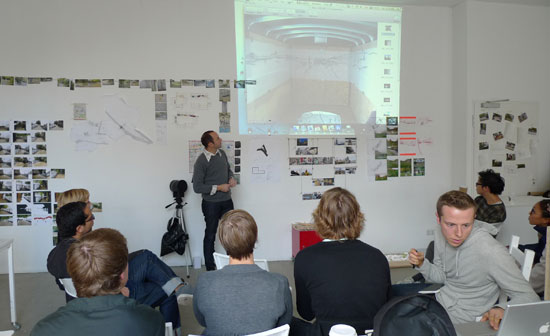
In its contemporary form, Berlin stands in opposition to the perceived permanence of the stone, steel, and glass it is built of. It is a city that has come to realize it is no more impervious to change than the bricks that have been removed and replaced by the dramatic cultural, political, and economic forces it has survived. As a result, Berlin has evolved to become a laboratory of adaptation, redefinition, and interpretation in the context of old assumptions and new unknowns. It is in this continual state of impermanence that Berlin has come to embrace the art of working with ephemeral conditions and expectations. An undergraduate and masters level architecture studio from the University of Manitoba, led by Professor Lancelot Coar, will examine this city as a model of an ever-changing city-form that has become increasingly constructed within the temporary situations and ideas it embodies. They will be study the Berlin as a contemporary model of a city and culture that has learned to re-appropriate the remains of past as a means to build for the immediate and indeterminate future.
In order to help with this, they will be exploring sites and projects that demonstrate subtle and radical approaches toward reclaiming the city through temporary constructions and temporary inhabitation. They will also visit sites of major architectural significance that have come to stand against and become marked by time in their own way. While in Berlin, they will collaborate with PROGRAM to uncover these ephemeral spaces and environments, and engage them through full-scale installations that provoke, extend, resist, or reframe what they find in order to better understand the potential it embodies. On Saturday October 22, Professor Coar and his studio will present their findings and interventions at PROGRAM, all are welcome and encouraged to attend.
student projects
Annelisse Westerbeek
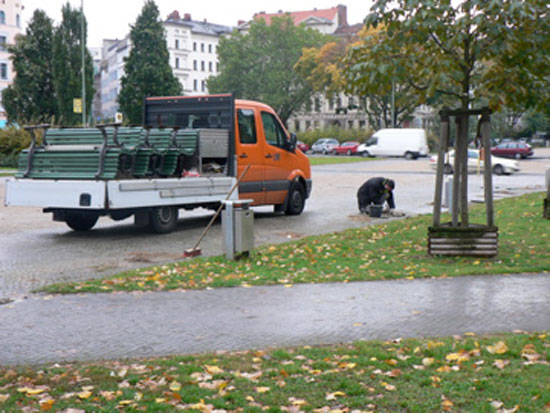
My project was all about closely observing a small area of Berlin to learn about other parts of the city. Ideally I would have observed a small area and then, from a higher view point like the Alexanderplatz tower, try to find areas similar or different from my first location. Limited access to higher viewpoints pushed me to compare to earlier experiences in the city. I started off by mapping out Oranienplatz but when I did not understand its where its edge was I began to explore it through the territory occupied by the green space. The next day I stayed in place and documented by note taking and sketching the life of those who inhabited and traveled through the park. I learned a lot about daily life in Berlin but came out of the assignment with even more questions. From this project I realized that in order to learn about a place, one first needs to know its history so that the details one observes may reveal greater meaning than simply observing the whole.
Brent Bell
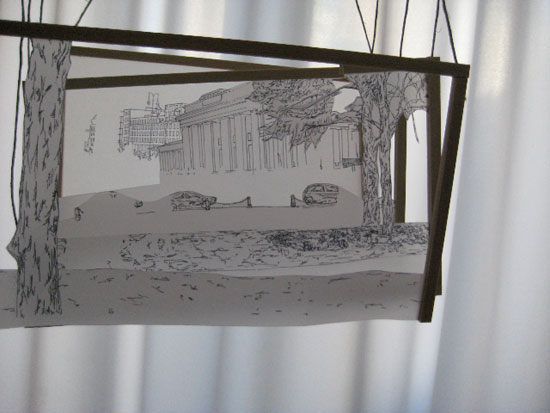
Upon the discovery of Berlin’s rich history of puppetry, and the recent performance by France’s Royal de Luxe street performers, the 3-day charrette focused on the traditional puppetry and set out to “play with a lack of control”. Berlin was to be viewed as a conventional tiered stage, and was sectioned into penetrable segments, which offered the opportunity to manipulate the scene of Berlin’s Brandenburg Gate. The division of the scenes provided the ability to restage the set by switching the positions of each tier. The scene was strung as a marionette and was controlled using a similar maneuverable rod mechanism.
This view of Berlin became backdrop for the performance of the day-to-day life of the city. The scale of the city stage and the position of the manipulator begin to question the role of the architect in the manipulation and creation of architecture. Architecture is control.
Brock Klassen
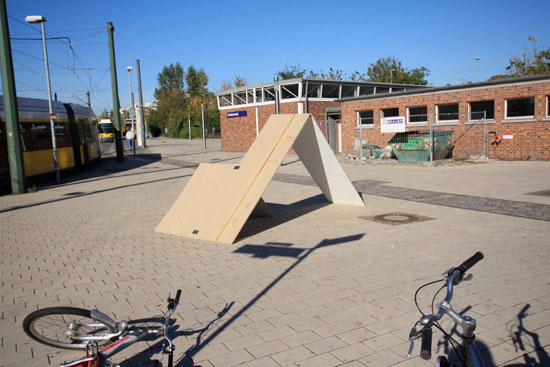
My research before traveling to Berlin was looking at temporary activations of the city, in particular I was looking at Archigram’s project for the “Instant City” and how that might be realized in my own work. I constructed a definition for myself so that I may have something to gauge my work against. Temporary activation is identified by three characteristics; action rather than contemplation or speculation, temporary engagement, and collective effort.
I decided upon attempting to act directly upon the city of Berlin. My plan was to create a structure and place it within the city, to observe how people reacted to it and act accordingly. I intentionally did not over think the form of what I built but rather allowed my available materials to prescribe my efforts. My installation was taken to the site of a train station and tested in a number of different locations. I quickly came to the realization that I had created a sculpture, the only temporary activation that occurred as consequence of the structure was my own as I built, moved and set up in the city.
I left the structure in its position with the intent of creating a final activation when the authorities would finally come to clean it up. A month later it still stands (with a few minor acts of vandalism) and has become a part of the infrastructure of Berlin.
David Kury
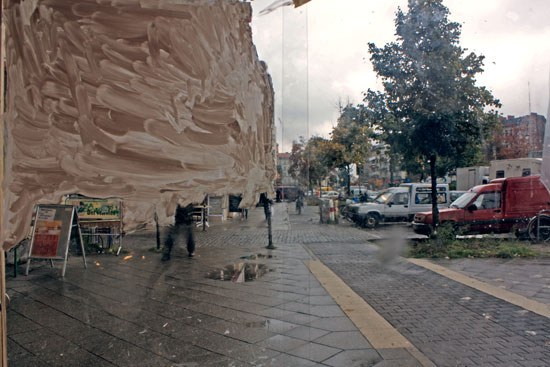
The focus of this investigation began with attempting to discover the relationship of differing elements of a landscape. The process began with the isolation of elements within a landscape: a plexiglass screen placed in front of a camera served as the drawing surface from which elements of the perspective were outlined and obscured from the image. The erasure of the object allowed the remainder of the image to be viewed as an entity. The isolation of the object “whited-out” with paint revealed the relationship of the object to its surrounding environment. Following the initial investigation, the project then evolved from isolating and dissecting elements of the landscape to the introduction of new elements into the landscape. By painting elements from one location and photographing their placement in a new perspective, the project examined the implications that these new forms had on their new situations.
Jacqueline Young
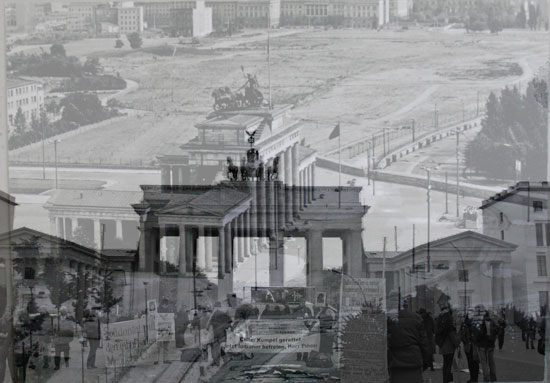
Part of Berlin's contemporary identity stems from the nature of its buildings and landscapes continually being reshaped and redefined. The impermanent framework that seeps its way through the city enhances the opportunity to view the temporal nature of space and how it is identified from one day to the next.
Through the use of pinhole photography, postcard images of landmark structures in the city were coated with a light sensitive emulsion in order to burn a picture of the present condition onto an image of the past. This layering of past and present conditions allows for the opportunity to view moments of time simulateneously and to gain an understanding of what is seen or what can be seen through the use of a device.
Jarrid Crichton
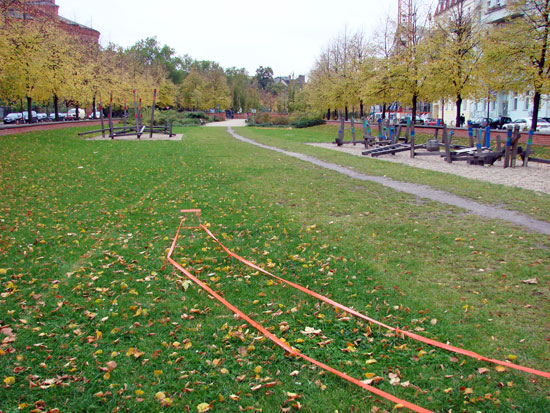
Beginning the project I was interested in questions of territory and “fluid space” - areas that act as interstitial spaces between designated zones. During my explorations of the city, I came across a park in Kreuzberg called Waldflanzengarten. The space had gone through successive periods of open inhabitation and restricted access. Originally a park, it had been turned into a canal system to move building materials into the city, then returned to a park, then closed off between the inner and outer sections of the Berlin Wall, and finally made into a park again.
In the park, some spaces appeared to be heavily used, such as the children’s play structures, and the beaten path through the grassy center. There were also large spaces that appeared to be mostly unused. I wondered if these spaces could be made more dynamic for a short period of time by encouraging people to come into them. I decided to create alternate “paths” by using flagging tape to mark out routes off of the main path into the grassy areas. At the end of each, I placed a plexiglass screen on which I traced the outline of the scene in front. As people moved through the park I circulated between the screens sketching in their forms as they passed. The aim was to get people interested in what the taped off paths and screens were, and to get them moving into the otherwise unused parts of the park.
Lindsey Salter
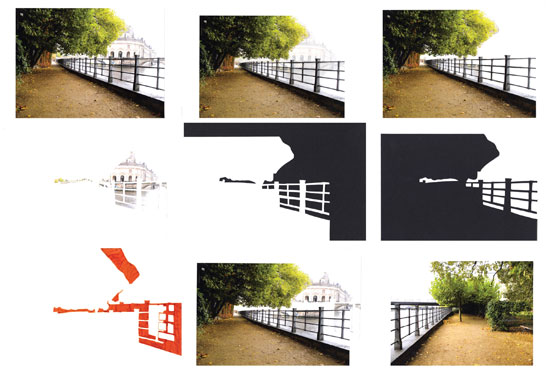
A river-walk near the Bode-Museum in Berlin, Germany was the site I chose to question the implication of rearranging the body of the city within a site. I explored how adding and subtracting elements of a site can change the nature of a place. The elements set into the space, questioned the consequence blocking and obscuring would have regarding a relationship of ‘site’ to its surroundings, the site at a specific location, and my body’s position within the site. Understanding the qualitative nature of blocking, obscuring and framing and how it is communicated through architecture will continue to be a driving force in my work.
Olivia Fung
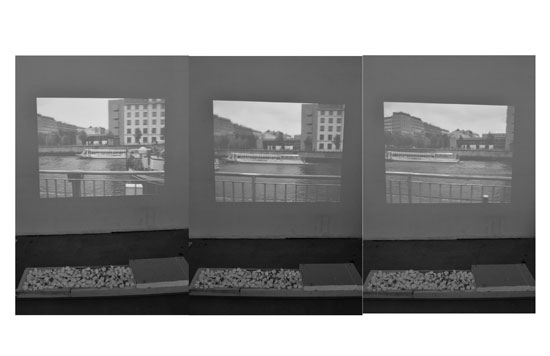
On the cold, wet, slippery, hard, rough, bumpy streets of Berlin, the memory of its sound became too hard to ignore. I often close my eyes and imagine what these surfaces would have sounded like 5 years ago, 10 years ago, 30 years ago, when the city was in ruins, in fortune and in crisis. The senses of the city talking to me through a contact of running, stomping, walking, dashing, stumbling, striding, wandering. In our studio’s investigation of “impermanence” and “temporality”, I decided to play with this idea of “remixing” the sounds of footsteps with what I was actually visually experiencing. A small pathway was constructed at PROGRAM covered in styrofoam bits as a way of changing the space’s existing cement surface but yet mimicking the visual texture of what was apparent on my memorable walk along the River Canal. This recording became a projection above the constructed pathway as a way of displacing one experience from another.
Zephyra Vun
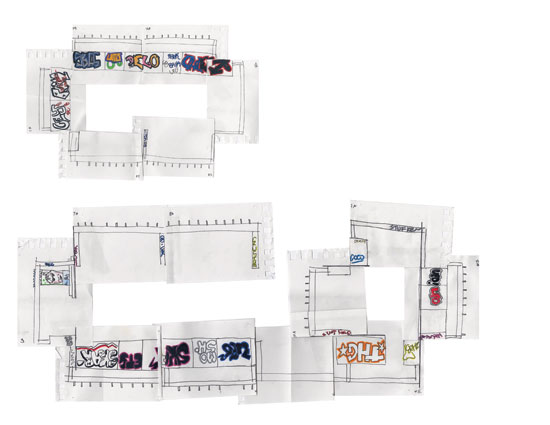
During my visit to Berlin, I became intrigued by the significant amount of graffiti that coated the cities facades, especially within the area of Kreuzberg. My focus during the three-day charette was the interpretation of this graffiti as compositional, layered markings of identity – an act of territorializing and re-appropriating space within the diverse and dynamic neighbourhood of Kreuzberg.
I explored this concept through the pelting out of space – the spatial unfolding of a volume into a two-dimensional preserved state. I employed this particular process of understanding space to an abandoned structure nestled in a small park within Kreuzberg. The space itself, along with the “thickness” of applied graffiti on its walls suggested the existence of a former life or content within the site, having evolved and transformed over time. In pelting out this space by unfolding its skin, this allusion to the past (the accumulation of memory) was removed, leaving only a flattened representation of the site. Engaging space in this way instigated questions regarding temporary inhabitation and its role in contextualizing space within past and present conditions.